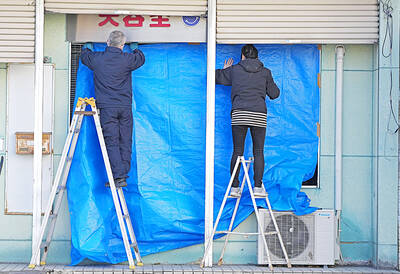The first batch of permanent houses for survivors of Typhoon Morakot is nearly completed, with residents planning to move in on Feb. 11.
Provided by Tzu Chi Foundation and Foxconn Technology Group, the site, located in Kaohsiung County’s Shanlin Township (杉林), will be able to accommodate about 1200 households after its second phase of construction is completed at the end of July.
Residents of the new site will come mainly from Aboriginal communities, including members of the Tsou tribe originally from Namasia Township (那瑪夏), Bunun Aborigines from Taoyuan Township (桃源) , Rukai Aborigines from Liukuei Township (六龜), Plains Aborigines from Jiasian Township (甲仙) and some Han people.
Premier Wu Den-yih (吳敦義) yesterday inspected the site to gain a better understanding of the preparatory work before the moving-in ceremony.
cooperation
The project would not have been completed in six months without the cooperation of the public and private sectors, NGOs and business, Wu said.
After the permanent houses are built, the government will continue to work with the groups to help people with employment opportunities by developing organic agriculture or making arts and crafts, as well as preserving their culture and heritage.
The other two sites for permanent houses will be built in Wulipu (五里埔), Kaohsiung County, mostly for residents who previously lived in Siaolin Village (小林) and Mahia Farm for residents from Wutai Township (霧台) and Sandimen (山地門) in Pingtung County.
anniversary
Post-Typhoon Morakot Reconstruction Commission vice chairman Chen Chen-chuan (陳振川) said the government hoped work on the two sites would be finished by the end of June, ahead of the first anniversary of the Aug. 8 flooding triggered by the typhoon.
Typhoon Morakot devastated southern Taiwan, leaving nearly 700 dead and a number of villages buried under mudslides.
Meanwhile, Chen added that the Council of Economic for Planning and Development is planning to build permanent houses for Aborigines living in high mountain villages found to be unsafe in Tainan County, Chiayi County, Taitung County to prevent possible future disasters.

Taiwanese were praised for their composure after a video filmed by Taiwanese tourists capturing the moment a magnitude 7.5 earthquake struck Japan’s Aomori Prefecture went viral on social media. The video shows a hotel room shaking violently amid Monday’s quake, with objects falling to the ground. Two Taiwanese began filming with their mobile phones, while two others held the sides of a TV to prevent it from falling. When the shaking stopped, the pair calmly took down the TV and laid it flat on a tatami mat, the video shows. The video also captured the group talking about the safety of their companions bathing

US climber Alex Honnold is to attempt to scale Taipei 101 without a rope and harness in a live Netflix special on Jan. 24, the streaming platform announced on Wednesday. Accounting for the time difference, the two-hour broadcast of Honnold’s climb, called Skyscraper Live, is to air on Jan. 23 in the US, Netflix said in a statement. Honnold, 40, was the first person ever to free solo climb the 900m El Capitan rock formation in Yosemite National Park — a feat that was recorded and later made into the 2018 documentary film Free Solo. Netflix previewed Skyscraper Live in October, after videos

Starting on Jan. 1, YouBike riders must have insurance to use the service, and a six-month trial of NT$5 coupons under certain conditions would be implemented to balance bike shortages, a joint statement from transportation departments across Taipei, New Taipei City and Taoyuan announced yesterday. The rental bike system operator said that coupons would be offered to riders to rent bikes from full stations, for riders who take out an electric-assisted bike from a full station, and for riders who return a bike to an empty station. All riders with YouBike accounts are automatically eligible for the program, and each membership account

A classified Pentagon-produced, multiyear assessment — the Overmatch brief — highlighted unreported Chinese capabilities to destroy US military assets and identified US supply chain choke points, painting a disturbing picture of waning US military might, a New York Times editorial published on Monday said. US Secretary of Defense Pete Hegseth’s comments in November last year that “we lose every time” in Pentagon-conducted war games pitting the US against China further highlighted the uncertainty about the US’ capability to intervene in the event of a Chinese invasion of Taiwan. “It shows the Pentagon’s overreliance on expensive, vulnerable weapons as adversaries field cheap, technologically